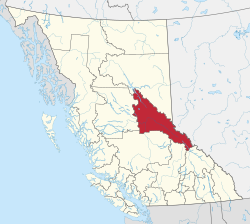Top Qs
Timeline
Chat
Perspective
Regional District of Fraser–Fort George
Regional district in British Columbia, Canada From Wikipedia, the free encyclopedia
Remove ads
The Regional District of Fraser–Fort George (RDFFG) is a regional district located in the Central Interior of British Columbia, Canada. It is bounded by the Alberta border to the east, the Columbia–Shuswap and Thompson–Nicola regional districts to the south and southeast, Cariboo Regional District to the southwest, the Regional District of Bulkley–Nechako to the west, and the Peace River Regional District to the north and northeast. As of the Canada 2011 Census, Fraser–Fort George had a population of 91,879 and a land area of 51,083.73 km2 (19,723.54 sq mi). The offices of the regional district are located at Prince George.
Remove ads
Communities
City
District municipality
Villages
Regional district electoral areas
- Fraser–Fort George A – Salmon River–Lakes
- Fraser–Fort George C – Chilako River–Nechako
- Fraser–Fort George D – Tabor Lake–Stone Creek
- Fraser–Fort George E – Woodpecker–Hixon
- Fraser–Fort George F – Willow River–Upper Fraser Valley
- Fraser–Fort George G – Crooked River–Parsnip
- Fraser–Fort George H – Robson Valley–Canoe
Indian Reserves
NB Indian Reserves are not part of municipal or regional district governance and are outside the regional district's jurisdiction, and also counted separately in the census figures.
- Fort George (Shelley) Indian Reserve No. 2
- McLeod Lake Indian Reserve No. 1
- Parsnip Indian Reserve No. 5
Designated places
Remove ads
Demographics
Summarize
Perspective
As a census division in the 2021 Census of Population conducted by Statistics Canada, the Regional District of Fraser-Fort George had a population of 96,979 living in 40,224 of its 43,377 total private dwellings, a change of 2.6% from its 2016 population of 94,506. With a land area of 50,580.72 km2 (19,529.33 sq mi), it had a population density of 1.9/km2 (5.0/sq mi) in 2021.[3]
- Note: Totals greater than 100% due to multiple origin responses.
Remove ads
Notes
References
External links
Wikiwand - on
Seamless Wikipedia browsing. On steroids.
Remove ads




